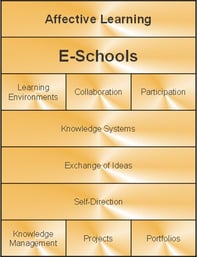Published on
Competency-Based Learning: Four Challenges and Impediments

As I’ve expressed in previous articles, which explore the student perspective and administrator perspective on competency-based learning (CBL), this approach to education holds the promise of positively disrupting the traditional Carnegie Unit and other time-based learning indicators that have served as the hallmark for how we deliver instruction and measure learning outcomes since the early 1900s.[1] However, the process of engraining CBL into the context of a traditional school, college or university is not without its considerations.
In this article, I assess the five most significant challenges standing in the way of the widespread adoption of CBL in higher education.
1. Assessment Standardization
According to Ralph Wolff, president of the Western Association of Schools and Colleges, institutions must guard themselves from standardizing the mechanisms in which competencies are demonstrated. Wolff, a participant on a recent Center for American Progress panel discussion, indicated that standardizing our approach to assessing competencies “… will not fundamentally improve the manner in which we measure student learning and outcomes”.[2] The very nature of CBL, also referred to as personalized learning, is ostensibly subject mastery; irrespective of time, space and pathway to completion.
But should each student be measured exactly the same for every performance outcome? Are there opportunities for students to demonstrate individualized subject mastery without adhering to standardized performance outcomes? Furthermore, who determines those outcomes and can — or should — they vary from institution to institution? Efforts from such organizations as the Association for Supervision and Curriculum Development have made significant strides in addressing these concerns. For example, in some school districts, academic materials are matched to the students’ developmental needs. This strategy must make the leap from K-12 to college and university levels.
2. Professional Licensure
Pioneering efforts within schools of nursing — such as those in the Massachusetts Department of Higher Education — are illustrating that a CBL model is an effective approach to both education and practice.[3] However, academic programs that require professional licensure may be slow to embrace competency programs divorced from any observable measures of contact hours. Compounding this concern, these licensures may vary from state to state. Many regulatory and accreditation agencies still require credit hours to be mapped to performance examinations. This approach is loudly supported by licensure boards that are slow to adapt.
To address this concern, some institutions have implemented a ‘backward’ approach to their competency programs by mapping the traditional credit hour to the performance examinations and competency assessments.[4] While this effectively placates regulatory agencies, it still binds the competency program to a credit-hour model.
3. Financial Aid
Last year, Eduardo Ochoa, assistant secretary for postsecondary education at the Department of Education, indicated that, while competency-based programs hold significant promise of reducing educational costs for students, there remains the concern regarding what our financial aid models will look like as this shift unfolds.[5] Until recently, most federal financial aid was strictly tied to credit hour production.
However, in March, the Department of Education signaled that colleges can now apply for federal financial aid for programs based on competency and direct assessment. The problem for the Department now becomes how to guard against fraud while still providing students the funds they need to participate in these non-traditional programs.[6]
4. Broad Recognition and Understanding
CBL is still a relatively new learning format. As freshly minted graduates present themselves in the job market, they are often greeted by skeptical employers who have never heard of the format or the degree-granting institution. Moreover, many employers are rigidly bound to hiring students hailing from traditional programs and who attain a certain grade point average. Anecdotal feedback from students who are matriculating into the job market from competency programs generally supports this skepticism.
However, thanks to efforts from the Lumina Foundation, a Degree Qualifications Profile has been developed that builds a common taxonomy for faculty, administrators, employers and policymakers. Comprised of more than 200 institutions, this framework will assist stakeholders in understanding what constitutes a “competency-based” model for learning.[7] Still, ‘unhooking’ the traditional curriculum from the school calendar and grade attainment perhaps remains the most significant impediment to wide-scale adoption.[8] Indeed, the biggest resistance may actually come from outside the academy.
Final Thoughts
Many of these impediments are bureaucratic and logistical in nature. As progressive educational reform movements take root, these aforementioned impediments will likely be mitigated. In fact, efforts are well underway to resolve many of these challenges. Efforts from organizations such as the Lumina Foundation and the Center for American Progress are assisting in the recognition and understanding of CBL through promotion and exposure.
– – – –
References
[1] The Carnegie Foundation for the Advancement of Teaching. “The Carnegie Unit: What Is It?” Retrieved from: http://www.suny.edu/facultysenate/TheCarnegieUnit.pdf
[2] Center for American Progress. “The Opportunities and Challenges of Competency-Based Learning”. Retrieved from: http://www.americanprogress.org/issues/higher-education/news/2012/06/08/11725/the-opportunities-and-challenges-of-competency-based-education/
[3] Maureen Sroczynski, Gayle Gravlin, Paulette Symour Route, Nancy Hoffart, Patricia Creelman. “Creativity and Connections: The Future of Nursing Education and Practice: The Massachusetts Initiative.” Retrieved from: http://www.mass.edu/currentinit/documents/nursing/nofarticle.pdf
[4] Center for American Progress
[5] Ibid
[6] Kelly Field. “Student Aid Can Now Be Awarded for Competencies, Not Just Credit Hours, U.S. Says”. Retrieved from: http://chronicle.com/article/Student-Aid-Can-Be-Awarded-for/137991/
[7] Jamie Merisotis. “Competency-Based Learning: A Big Deal, But Not Because of the Feds”. Retrieved from: http://www.huffingtonpost.com/jamie-merisotis/competencybased-learning-_b_2994751.html
[8] Jennifer Hemmingsen. “Another Challenge for the Competency Classroom: Explaining It”. Retrieved from: http://thegazette.com/2013/07/01/another-challenge-for-the-competency-based-classroom-explaining-it/
To read Gibson’s first article, looking at competency-based education from the student perspective, please click here. For his second article on competency-based education from the administrator perspective, please click here.



